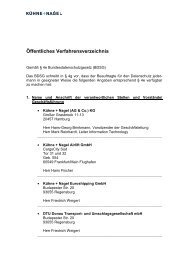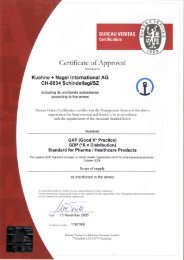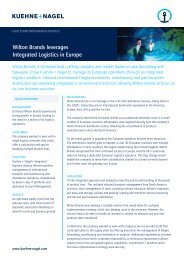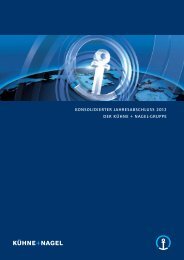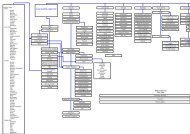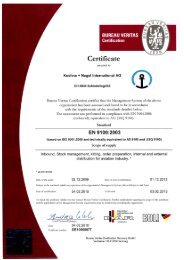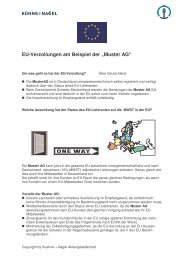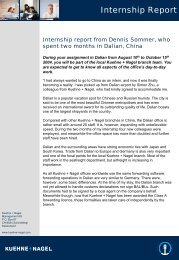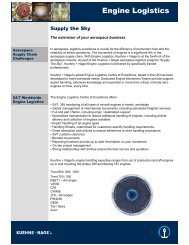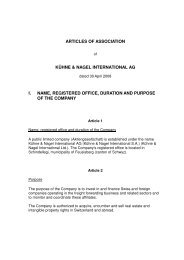ANNUAL REPORT 2011 - Kuehne + Nagel
ANNUAL REPORT 2011 - Kuehne + Nagel
ANNUAL REPORT 2011 - Kuehne + Nagel
Create successful ePaper yourself
Turn your PDF publications into a flip-book with our unique Google optimized e-Paper software.
70<br />
Consolidated Financial Statements <strong>2011</strong> _ _ _ _ _ _ Accounting Policies<br />
18 Income taxes<br />
Income tax on earnings for the year comprises current and<br />
deferred tax. Both current and deferred tax are recognised in the<br />
income statement, except to the extent that the tax relates to<br />
business combinations or items recognised directly in equity or<br />
in other comprehensive income.<br />
Current tax is the expected tax payable or receivable on the taxable<br />
income or loss for the year, using tax rates enacted or substantially<br />
enacted at the balance sheet date and any adjustment<br />
to tax payable for previous years.<br />
Deferred tax is recognised based on the balance sheet liability<br />
method, on temporary differences between the carrying<br />
amounts of assets and liabilities for financial reporting purposes<br />
and their tax base. The following temporary differences are not<br />
accounted for: Initial recognition of goodwill, initial recognition<br />
of assets or liabilities that affects neither accounting nor taxable<br />
profit, and differences relating to investments in subsidiaries<br />
to the extent that they will probably not reverse in the<br />
foreseeable future. The amount of deferred tax recognised is<br />
based on the expected manner of realisation or settlement of<br />
the carrying amount of assets and liabilities, using tax rates<br />
enacted or substantially enacted at the balance sheet date.<br />
A deferred tax asset in respect of temporary differences or<br />
unused tax losses is recognised only to the extent it is probable<br />
that future taxable profits will be available against which the<br />
asset can be utilised. Deferred tax assets are reduced to the<br />
extent it is no longer probable that the related tax benefit will<br />
be realised.<br />
19 Non-current assets held for sale<br />
and discontinued operations<br />
Non-current assets (or disposal groups) are classified as held for<br />
sale if their carrying amount will be recovered principally<br />
through a sale transaction rather than from continuing use. The<br />
asset (or disposal group) must be available for immediate sale<br />
in its present condition and the sale must be highly probable.<br />
Immediately before classification as held for sale, the measurement<br />
of the assets (and all assets and liabilities in a disposal<br />
group) is updated in accordance with applicable IFRS. Then,<br />
on initial classification as held for sale, non-current assets and<br />
disposal groups are recognised at the lower of carrying amount<br />
and fair value less costs to sell. Impairment losses on initial<br />
classification as held for sale are included in the income<br />
statement. Intangible assets and property, plant and equipment<br />
once classified as held for sale are not amortised or<br />
depreciated.<br />
A discontinued operation is a component of the Group’s business<br />
that represents a separate major line of business or geographical<br />
area of operations, or is a company acquired exclusively<br />
with a view to resale. Classification as a discontinued<br />
operation occurs upon disposal or, if earlier, when the operation<br />
meets the criteria to be classified as held for sale.





